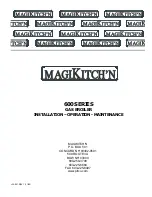
21
LP- 276 REV. 9.4.14
pH of Water
pH is a measure of relative acidity, neutrality or alkalinity. Dissolved minerals and gases affect water pH. The pH scale ranges from 0 to
14. Water with a pH of 7.0 is considered neutral. Water with a pH lower than 7 is considered acidic. Water pH higher than 7 is
considered alkaline. A neutral pH (around 7) is desirable for most potable water applications.
Corrosion damage and heater failures
resulting from water pH levels of lower than 6 or higher than 8 ARE NOT covered by the warranty.
The ideal pH range for water
used in a storage tank or a water heater system is 7.2 to 7.8.
Total Dissolved Solids
Total Dissolved Solids (TDS) is a measurement of all minerals and solids dissolved in a water sample. The concentration of total
dissolved solids is usually expressed in parts per million (ppm).
Water with a high TDS concentration will greatly accelerate lime and scale formation in the hot water system. Most high TDS
concentrations precipitate out of the water when heated. This can generate a scale accumulation on the heat transfer surface that will
greatly reduce the service life of a water heater. This scale accumulation can also impede the ability of the heat exchanger to transfer
heat into the water. A heat exchanger damaged or blocked by lime/scale accumulation must be replaced.
The manufacturer of the water heater has no control of water quality, especially TDS levels in your system. Total dissolved solids in
excess of 2,000 ppm will accelerate lime and scale formation in the heat exchanger. Heat exchanger failure due to total dissolved solids
in excess of 2,000 ppm is a non-warrantable condition.
Failure of a water heater due to lime scale build up on the heating surface
IS NOT covered by the warranty.
Hardness:
7 grains
Chloride levels:
100 ppm
pH levels:
6-8
TDS:
2000 ppm
Sodium:
20 mGL
*NOTE:
It is recommended you clean heat exchanger at least once a year to prevent lime scale buildup. Follow the maintenance
procedure to clean the heat exchanger in the Maintenance Section (Part 12 of this manual).
Piping components
Water heating system piping:
Water boiler system piping MUST be sized per technical pipe requirements listed in Table 9. Reducing pipe size can restrict flow rate
through the boiler, causing inadvertent short cycling and poor system performance.
Check valves:
Field supplied. Check valves are recommended for installation as shown in Piping Details.
Water boiler isolation valves:
Field supplied. Full port ball valves are required. Failure to use full port ball valves could result in a restricted flow rate through the water
boiler.
Anti-scald mixing valve:
Field supplied. A thermostatic mixing valve is recommended when storing domestic hot water above 115°F.
Unions:
Field supplied: Recommended for unit serviceability.
DO NOT USE DIELECTRIC UNIONS!
ONLY BRASS, COPPER, OR STAINLESS STEEL.
Pressure relief valve:
Factory supplied on VWH. The pressure relief valve is sized to ASME specifications. Storage tank may require additional relief valves
depending on local codes.
Summary of Contents for Mod Con 300 VWH
Page 12: ...12 LP 276 REV 9 4 14 Figure 2 Dimensions and Specifications ...
Page 22: ...22 LP 276 REV 9 4 14 I PIPING DIAGRAMS Figure 6 ...
Page 49: ...49 LP 276 REV 9 4 14 Figure 28 Mod Con Internal Connection Diagram LP 255 ...
Page 63: ...63 LP 276 REV 9 4 14 Figure 31 ...
Page 64: ...64 LP 276 REV 9 4 14 Figure 32 ...
Page 65: ...65 LP 276 REV 9 4 14 Figure 33 NOTE Ceramic Refractory Part 7250P 162 ...
Page 66: ...66 LP 276 REV 9 4 14 Figure 34 ...
Page 67: ...67 LP 276 REV 9 4 14 Figure 35 ...
Page 70: ...70 LP 276 REV 9 4 14 ...
Page 71: ...71 LP 276 REV 9 4 14 ...
















































